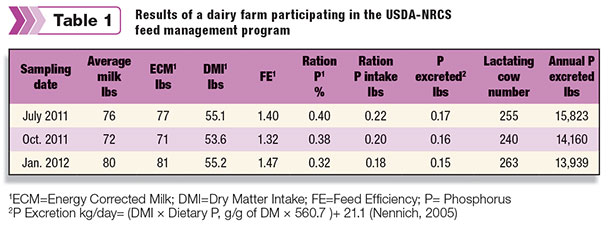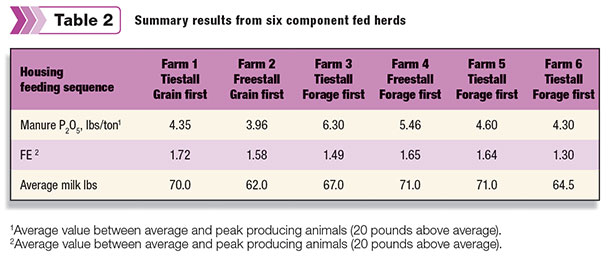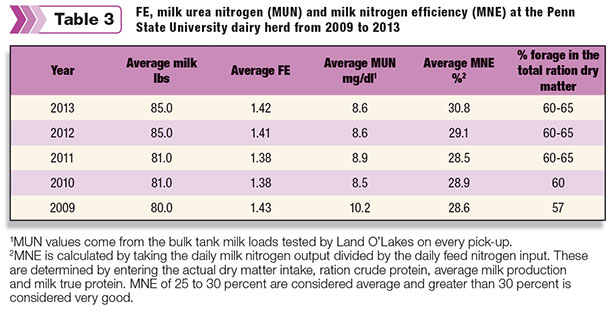In the previous two articles, feed efficiency (FE) has been defined, and its use as a stand-alone monitoring tool or in conjunction with income over feed costs has been examined. The other opportunity for using FE is evaluating the potential impact on manure volume excretion as well as its nutrients. This could have implications for farms with a limited land base or need to export manure off-farm.
In Pennsylvania for the last seven years, the Penn State Extension Dairy Team and the Natural Resources Conservation Service (NRCS) have teamed together to qualify American Registry of Professional Animal Scientists (ARPAS), certified livestock nutritionists, to write feed management plans for dairy and beef cattle.
This program certifies consultants in precision feed management, a practice that reduces nutrient loads in animal wastes by minimizing the phosphorus and nitrogen content in the feed. Over the years, the work of this project team has established precision feed management as both an economically and environmentally viable best management practice.
As such, state watershed implementation plans include precision feed management as a method to meet load allocations. To date, the program has fully qualified 24 feed management plan writers. Currently, approximately 55 dairy or beef operations in Pennsylvania have participated in a feed management contract with NRCS.
One of the monitoring metrics in a feed management plan is dry matter intake efficiency, or FE. For lactating dairy cows, FE equals energy-corrected milk divided by dry matter intake. Another metric monitored is income over feed costs (IOFC).
This is calculated by taking the all-milk price per hundredweight times the daily average milk production divided by 100 minus the daily feed cost per cow. Tying FE with environmental concerns is not as simple or clear cut as it may be with IOFC.
There are several challenges of connecting FE with manure volume and nutrients. Storage structures for manure typically include other wastes or liquids entering the structure. So even if FE did reduce the volume of manure being excreted by the animal, it may be difficult to quantify the amounts on the whole-farm system.
In theory, if manure volume is reduced, so are the levels of manure nutrients, particularly phosphorus. Nitrogen is very difficult to quantify since it is so volatile. For that reason milk urea nitrogen (mg per deciliter) or milk nitrogen efficiency (percentage) are monitored along with FE.
An objective of the feed management program in Pennsylvania is to implement precision feeding practices and reduce the nutrients being excreted. Livestock operations that participate in the program have intense sampling of feeds, manure and milk (dairy operations) on a quarterly basis.
Farms must demonstrate either through nutrition or feeding management practices that cows are fed phosphorus and nitrogen close to the animals’ requirements. Fecal phosphorus is monitored in the animal groups to illustrate that precision feeding is working.
Table 1 shows results from a dairy operation participating in the feed management program in which management practices have been implemented to improve efficiencies and nutrient output.

FE is a value that should be monitored over time as changes are implemented on a farm. Evaluating FE at one point in time probably will not convey too much useful information. In the winter of 2013, six component-fed herds were evaluated for their feeding management practices and the amount of phosphorus excreted.
Portable scales were used to weigh out individual forages and grains to several cows at average and peak production. All feeds were sampled and analyzed. Table 2 shows the results from this project. All of these farms were practicing adequate feeding management practices.

Ration phosphorus was fed close to the cows’ requirements, which is reflected in the manure P2O5. However, the FE ranged from a low of 1.30 to a high of 1.72. There did not appear to be any correlation between FE and fecal phosphorus when examining sample results at one time point.
In July 2013, manure was sampled from the lactating cows at the Penn State dairy herd. They were fed a TMR. The manure P2O5 tested 3.65 pounds per ton, FE was 1.45 and average milk production 80 pounds.
Evaluating the herd over the past 5 years, manure P2O5 has averaged 3 pounds per ton with an average FE of 1.40. This is the result of implementing precision feeding and keeping phosphorus intake close to the cows’ requirements.
However, it would be extremely difficult to make any comparisons between the Penn State dairy and another farm. A snapshot in time will not provide much useful information. It is for that reason the feed management program implemented in Pennsylvania examines results quarterly and yearly.
Another aspect of using FE is comparing it to either milk urea nitrogen (MUN) or milk nitrogen efficiency (MNE). These are other metrics monitored in the feed management program in Pennsylvania to evaluate how the herd or groups of animals are progressing over time.
Table 3 illustrates how the Penn State dairy herd has been doing over the past five years. Precision feeding has been implemented from 2009 through 2013. This addresses forage quality, feeding a consistent ration and grouping cows according to production and age. The herd has maintained similar efficiencies over time with the trend toward improving MNE.

Using a single metric, such as FE, and making a blanket statement about a herd’s performance could be incorrect or misleading. The value of FE is using it in conjunction with other metrics and being inclusive.
There needs to be the connection with the economics as well as the environmental aspects. Singling out one number at one time point does not provide much insight into what is occurring on the farm.
Unfortunately, the majority of operations do not make monitoring these performance indicators a priority. The feed management program offered by NRCS is a means of tracking these kinds of information.
By implementing changes in feeding management and monitoring these metrics, improvements will hopefully show in profitability and nutrients excreted. That is where the true value will be observed. PD

Virginia Ishler
Dairy Complex Manager and Extension Specialist
Penn State University






